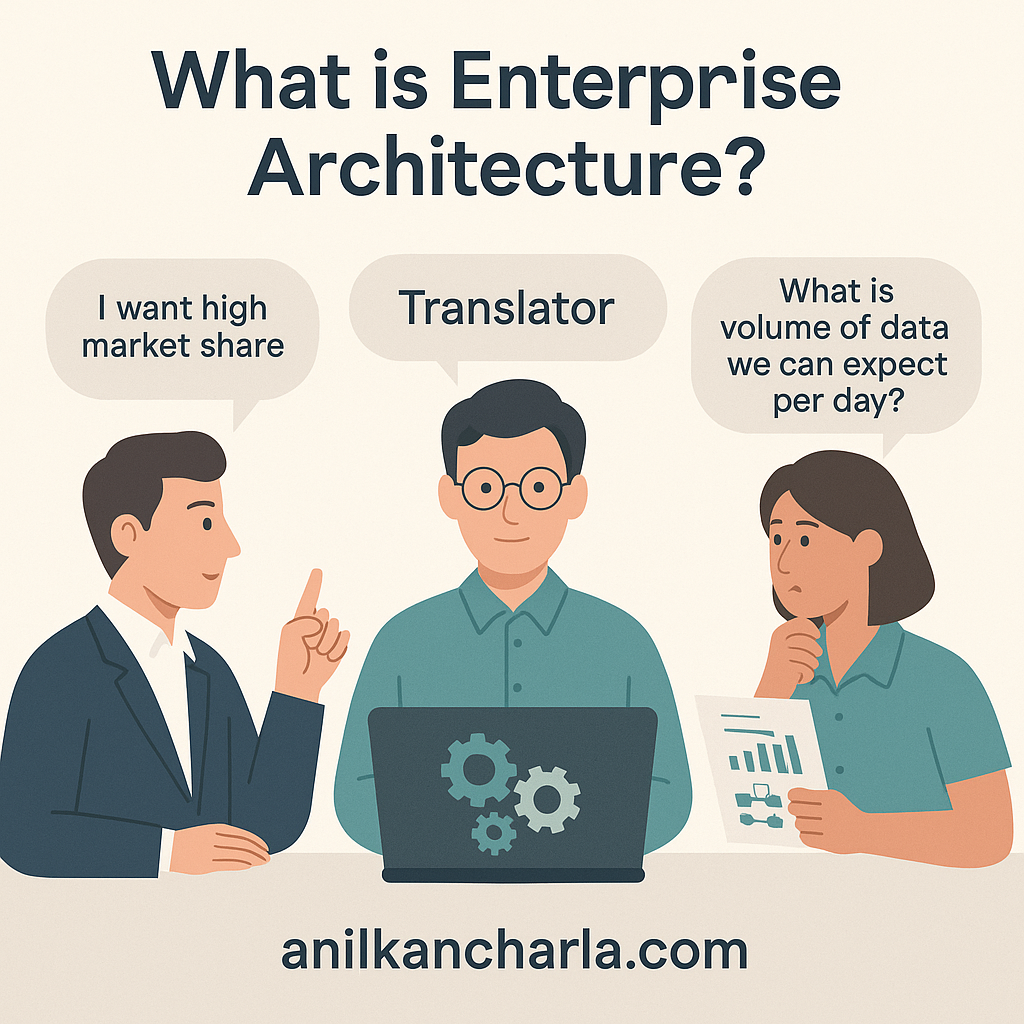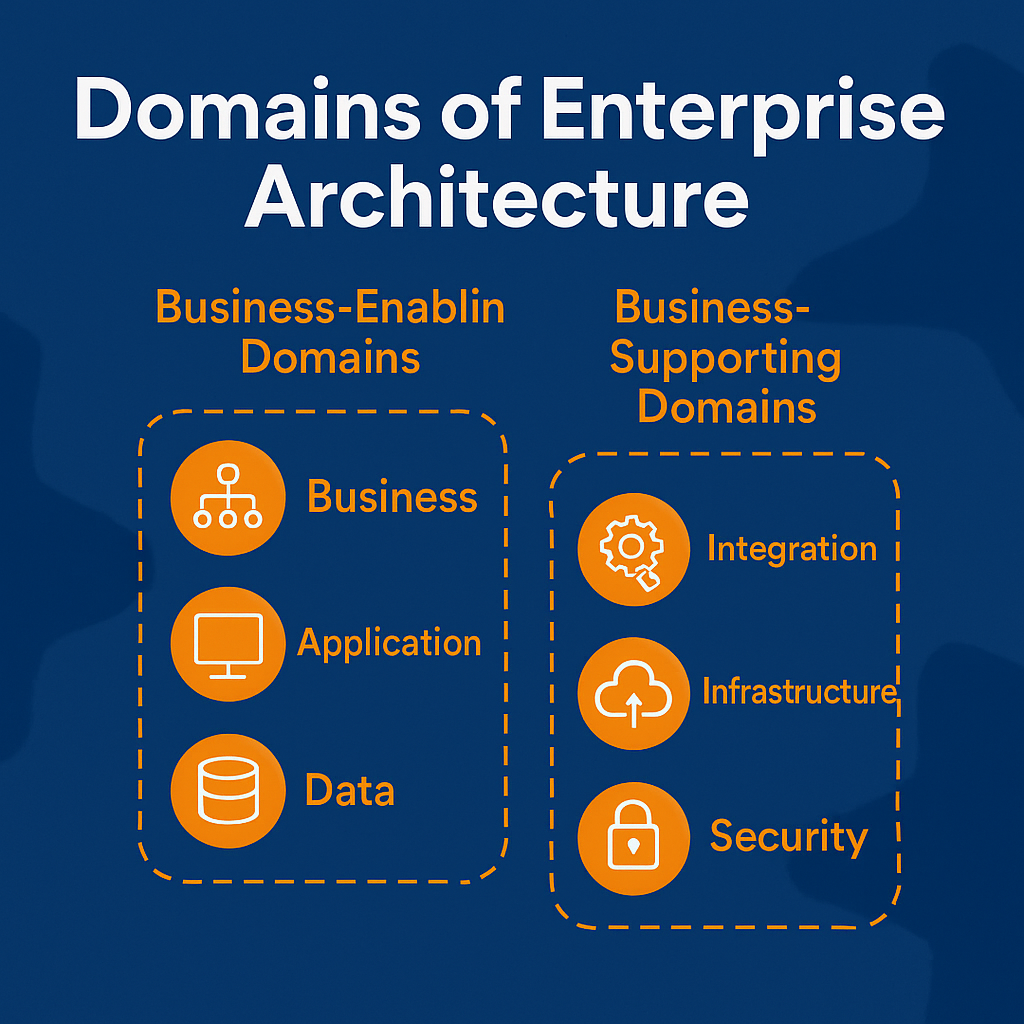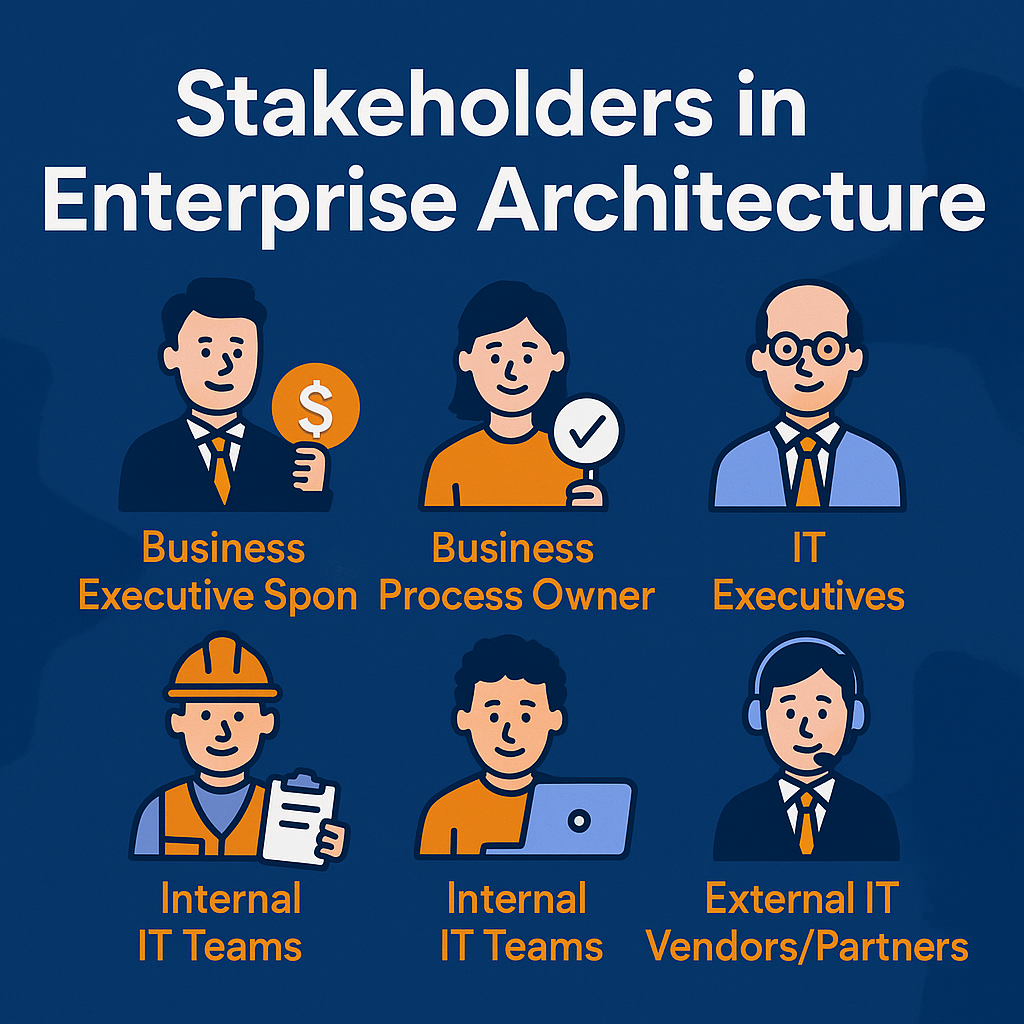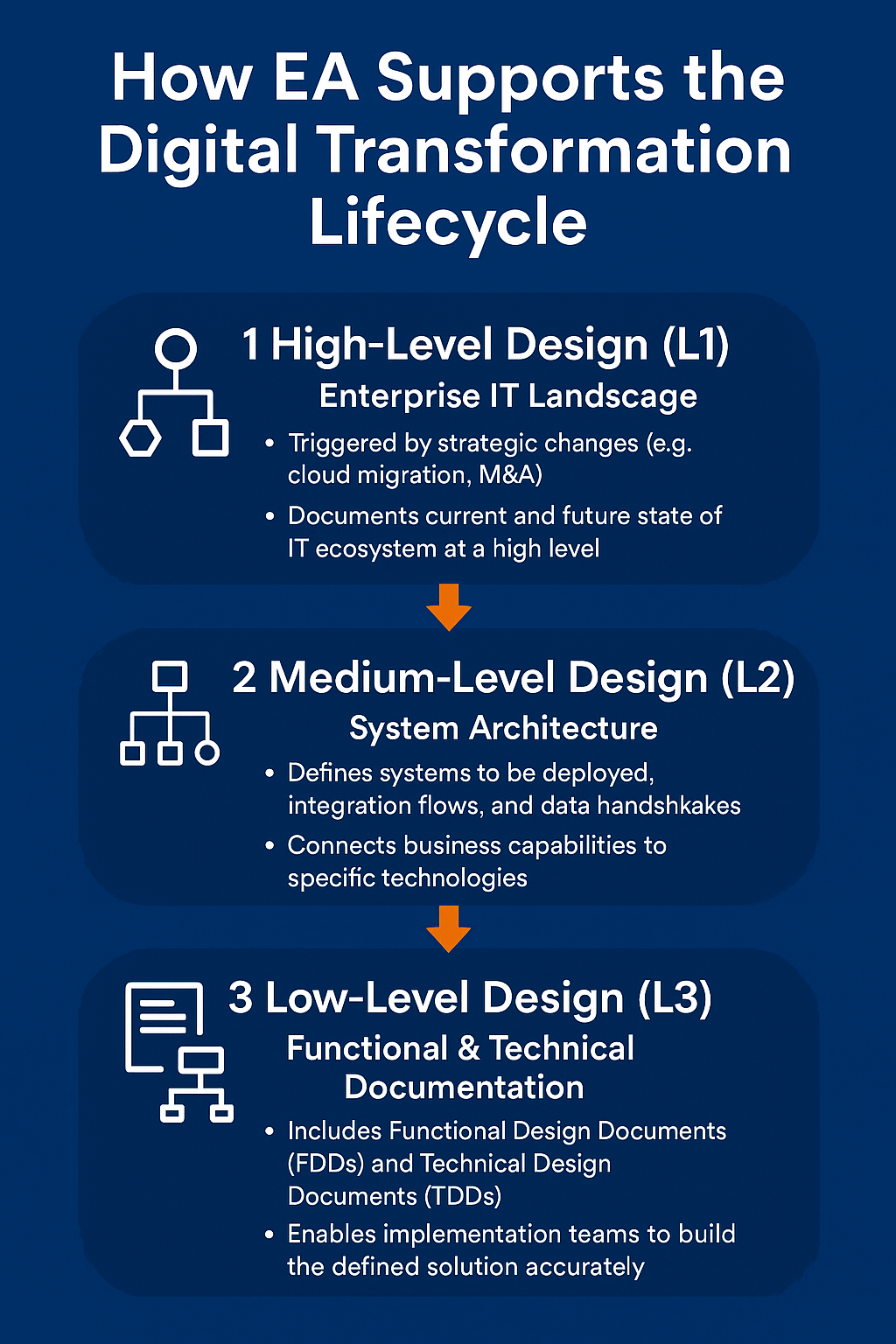Enterprise Architecture Basics: Core Concepts, Domains, Types, and Key Components Explained
2025-05-28 · By Anil Kancharla · 7 min read
❤️ 0 Likes · 👁️ 0 Views

What Is Enterprise Architecture? A Foundational Guide for Digital Transformation
Enterprise Architecture (EA) is one of the most critical yet often misunderstood disciplines in digital transformation. Whether you're a business executive, IT strategist, or consultant, understanding Enterprise Architecture (EA) can help bridge the persistent gap between vision and execution.
This guide provides a clear, experience-based explanation of what enterprise architecture is, why it’s essential, how it supports digital transformation, and the modern frameworks and tools shaping its future.
💡 What Is Enterprise Architecture?
An enterprise consists of interconnected organizational units—encompassing people, processes, information, and technology—working together to achieve a shared goal. Within this complex system, stakeholders often speak different languages, employ various tools, and pursue distinct objectives.
Organizations grow organically, not mechanically. This organic evolution can result in fragmented systems and misaligned priorities.
That’s where Enterprise Architecture comes in.
In simple terms:
Enterprise Architecture is a structured approach to understanding, aligning, and evolving an organization's people, processes, and technologies to achieve its strategic goals.
According to Svyatoslav Kotusev, author of The Practice of Enterprise Architecture:
“Enterprise Architecture is a collection of special documents for communication between business and IT teams.”
In practice, EA serves as a translator between business and IT, ensuring collaboration, clarity, and a shared understanding across the organization.

🚀 Why Do We Need EA in Digital Transformation Projects?
The most significant risk in digital transformation is the misalignment between business and IT.
- Business executives define strategy, vision, and goals.
- IT teams must implement solutions that support those goals, often without full context or alignment.
Where business users prioritize growth, customer experience, and competitive advantage, IT focuses on architecture, scalability, and compliance.
Enterprise Architecture bridges this gap, creating a standard structure, language, and methodology that ensures strategy becomes a reality—efficiently, securely, and sustainably.
🧱 Domains in Enterprise Architecture
Enterprise Architecture is typically organized into core domains to help stakeholders understand the structure and flow of the enterprise.

🔹 Business-Enabling Domains
These drive innovation and support business operations directly:
- Business Domain – Defines business processes, goals, and capabilities.
- Application Domain – Maps software systems that support those processes
- Data Domain – Structures data assets, flows, quality, and governance
🔸 Business-Supporting Domains
These provide the technical foundation to enable and protect business systems:
- Integration Domain – Interfaces, APIs, and middleware
- Infrastructure Domain – Servers, cloud, networks, and hosting environments
- Security Domain – Policies, access controls, and cybersecurity architecture
This layered model ensures enterprise-wide alignment across both business and technical perspectives.
👥 Stakeholders in Enterprise Architecture

A strong EA function is inherently collaborative. Key stakeholders include:
- Business Executive Sponsors
- Business Process Owners
- IT Executives
- IT Project Managers
- Internal IT Teams
- External IT Partners or Vendors
Effective EA occurs when all parties agree on a familiar path, using shared documentation and decision-making frameworks.
🔄 How Enterprise Architecture Supports the Digital Transformation Lifecycle
Enterprise Architecture (EA) provides a structured approach to digital transformation by supporting decision-making and alignment across three levels of design—from strategic planning to technical execution.
Let’s explore each level through a real-world analogy: expanding into a new market using a unification model (where most existing systems and processes remain unchanged).
1️⃣ High-Level Design (L1): Enterprise IT Landscape
At this stage, the business makes a strategic decision, such as entering a new geographic market. From an EA perspective, this triggers a review of the current IT landscape and a proposal for what the future should look like to support this expansion.
- What does the existing architecture look like?
- What changes are required at a high level?
- What will the IT footprint of the new market look like?
📌 Analogy:
Imagine a company deciding to expand into a new country. The business strategy is in place, and the EA team outlines what infrastructure (systems, processes, teams) must be replicated or extended. This is the blueprint for the new region, assuming current operations remain largely the same—a classic unification model.
2️⃣ Medium-Level Design (L2): System Architecture
Here, architects define how systems will operate to support the business plan. This includes integration points, data flows, and system timelines.
- What applications need to be deployed?
- How will data flow across systems?
- What changes need to occur in phases?
📌 Analogy:
Continuing the market expansion example, at L2 you define how existing ERP, CRM, or SCM systems will connect with new regional operations. What APIs need to be updated? When will each rollout occur? Which legacy systems (if any) need integration?
3️⃣ Low-Level Design (L3): Functional & Technical Documentation
This level involves detailed documentation like Functional Design Documents (FDDs) and Technical Design Documents (TDDs). It translates architectural decisions into executable specifications.
- What features need to be configured or developed?
- What data fields, roles, and workflows are changing?
- How are these changes tested and deployed?
📌 Analogy:
Now you're working at the implementation level—defining every screen, report, user role, and integration logic. This is where the development and configuration teams take over to build the systems as per the EA roadmap.
🧩 Summary Table
| Level | Description | Key Output | Example | | --- | --- | --- | --- | | L1 | Strategic IT Landscape | Future State Architecture | Expansion plan blueprint | | L2 | System Architecture | Integration & Flow Design | System rollout timeline | | L3 | Functional/Technical Design | FDDs, TDDs | Detailed build specs |

🧭 EA Frameworks and Tools in 2025: What’s Leading the Way?
Today’s enterprise architects go beyond static models—they rely on modern frameworks and dynamic tools to support real-time collaboration, scenario planning, and architecture governance.
📚 Popular Enterprise Architecture Frameworks
FrameworkDescription
TOGAF® 10th Edition Modular, adaptable, widely used—now more agile and iterative
ArchiMate® 3.2 is A complementary modeling language that provides layered architecture views.
BizBok® , from the Business Architecture Guild, focused on business capability modeling.
SABSA Security-focused EA framework for enterprise risk and assurance alignment
Gartner’s Continuous EA Model emphasizes continuous, outcome-driven Enterprise Architecture (EA) practices.
Kotusev’s EA Practice Model is a Research-based, document-centric model rooted in real-world EA practices.
🛠 Modern EA Tools
ToolKey Strengths
Sparx Enterprise Architect: A Robust modeling platform for TOGAF, UML, BPMN, ArchiMate
Bizzdesign HoriZZon Strategic planning, architecture governance, and stakeholder collaboration
Ardoq Data-driven EA with visualization, dependency analysis, and graph modeling
LeanIX SaaS-native with strong APM (Application Portfolio Management) and integrations
Avolution ABACUS Customizable modeling with simulation and cost analysis capabilities
Modelio / Archi (Open Source): Lightweight tools for learning and modeling with ArchiMate
These frameworks and platforms support dynamic, scalable EA practices, fostering alignment in fast-paced transformation projects.
✅ Final Thoughts
Enterprise Architecture is not a one-time deliverable. It’s a strategic foundation for digital transformation, ensuring that business strategy, IT systems, and operational execution remain aligned as organizations evolve.
Whether you're launching a cloud migration, implementing Oracle Fusion, or designing a future-ready operating model, EA helps you make decisions with clarity and confidence.
💌 Enjoyed this article?
If you found this post valuable, subscribe to my newsletter for more insights on digital transformation, AI, and business innovation.
👉 Subscribe to the newsletterOr let’s connect on LinkedIn — I share weekly content that’s practical for CIOs, CFOs, and transformation leaders.
🔗 Connect with me on LinkedIn